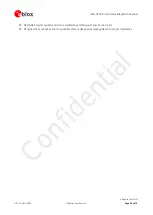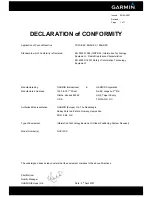
UBX-G7020 - Hardware Integration Manual
Design-in
GPS.G7-HW-10003
Objective Specification
Page 45 of 74
With the Low Level Configuration set by the configuration pins, it should be able to start up with the correct
clock/oscillator setting to enable the host to communicate with the UBX-G7020. Thus starting in Safe Boot Mode
is not required and the host is able to communicate with the UBX-G7020 to set the eFuse Low Level
Configuration.
All UBX-G7020 ROM based designs using the default clock frequency with PIO0 to PIO5 set correctly are
able to communicate to a host by UART, DDC, SPI, or USB without entering the Safe Boot Mode.
All UBX-G7020 ROM based designs using the default clock frequency and set the PIO0 to PIO5 correctly,
are able to communicate to a host without entering the Safe Boot Mode by UART, DDC, SPI, or USB.
2.10.2.3
Low Level Configuration saved in SQI Flash
If the firmware runs out of SQI flash, partial Low Level Configuration can be saved in the SQI flash too. Thus the
Low Level Configuration can be changed more often compared to the one time programming of the eFuse. The
part of the Low Level Configuration set in SQI flash has a higher priority than the Low Level Configuration set by
the eFuse!
If the SQI flash is only used to log data, the Low Level Configuration cannot be saved in the SQI flash. Only if the
firmware runs from the SQI flash can the Low Level Configuration be saved in the SQI flash.
If an SQI flash is connected to the UBX-G7020 without valid firmware contents (e.g. corrupted firmware code or
none programmed), it will then only use the Low Level configuration from eFuse. So if the firmware gets
corrupted, the receiver might not run at all, because of a potentially wrong Low Level Configuration.
Even if all the Low Level Configuration can be saved in SQI flash it is recommended to also set all the
Low Level Configuration in the eFuse as well. Thus if the SQI flash contents becomes corrupted the UBX-
G7020 is still able to start up correctly and the flash can be subsequently reprogrammed.
For designs with external SQI Flash and not using default clock settings (26MHz, 19pF crystal) it is
mandatory to initially startup in the Safe Boot Mode. Hence there must be a method to pull-down the
PIO12 (SAFEBOOT_N pin) during production!
A design using USB and SQI flash, but not using the clock/oscillator default settings must start up in production
in Safe Boot Mode. Owing to the internal ring oscillator it cannot use USB and hence will require another
communication interface to program the flash in production
Confidential
















































